Neuronal avalanches as potential features for Brain-Computer Interfaces
Résumé
Introduction:
Brain-Computer Interfaces (BCIs) constitute a promising tool for communication and control. However, controlling non-invasive BCI remains a learned skill difficult to develop for 15-30% of users (Allison et al., 2010). This is mainly due to our poor understanding of the dynamic processes underlying BCI performance. Identifying the dynamical features that are relevant to the execution of a task could be the key to improving the diffusion of the BCI. Current features rely on local measurements without considering the interconnected nature of brain functioning. Whole-brain functional imaging is dominated by 'bursty' dynamics, aperiodic perturbations called "Neuronal Avalanches" spreading across the whole brain (Tagliazucchi et al., 2012). Neuronal avalanches spread preferentially across the white-matter bundles (Sorrentino et al., 2021), are affected by neurodegenerative diseases (Sorrentino, et al., 2021). Here we hypothesise that they could improve BCI classification performance. To test our hypothesis, we used source- reconstructed EEG signals in a BCI framework, where 20 subjects were compared in resting state and while performing a motor imagery task. We obtained the probabilities of each pair of regions being recruited sequentially in an avalanche (Sorrentino et al., 2021), and we used them as features to perform the classification.
Methods:
Here, we applied the neuronal avalanches approach to EEG data recorded during a BCI training session performed by a group of 20 healthy subjects (aged 27.5±4.0 years old, 12 men). They were instructed to control the vertical position of a moving cursor by modulating their neural activity via a motor imagery task (Corsi et al., 2020). The signal was then zscored (over time) and thresholded, and set to 1 when above threshold, and to zero otherwise (threshold =|3|). An avalanche was defined as starting when at least one region is above threshold, and as finishing when no region is active. For each avalanche, we have estimated an avalanche transition matrix (ATM) containing the probability that regions j would be active at time t+1, when region i was active at time t. Then, for each subject, we obtained one ATM per trial. We explored the performance of the ATMs in the decoding of the task. We compared the ATMs and the Common Spatial Patterns (CSP) approaches, widely used in the BCI domain (Blankertz et al., 2008). In each case, the output was classified using a Support Vector Machine (SVM). The classification scores for all pipelines were evaluated with an accuracy measurement using a random permutation cross-validator. To enable a statistical comparison of the CSP+SVM and the ATM+SVM approaches, 50 re-shuffling and splitting iterations were performed.
Results:
At the group-level (Fig 1, panel A), the classification performance was greater for ATM+SVM (0.80+/-0.10) with a reduced inter-subject variability as compared to CSP+SVM (0.75+/-0.15).
For each subject, we ran t-tests to compare the 50 success rates obtained with CSP+SVM to the 50 success rates obtained using ATM+SVM. ATM+SVM yielded better classification accuracy than CSP+SVM for 12 subjects. In 4 subjects, CSPs yielded better accuracy than ATMs (Fig. 1, panel B). In 5 subjects, there was not any statistically significant difference between the two approaches. We examined the variability of the estimates across the splits. Steady estimates are important to train online algorithms and high variability might be partly responsible for ineffective training. We observed marginally higher intra-subject variability in CSP+SVM (median value of 0.07) as compared to ATM+SVM (median value of 0.06). In particular, the standard deviation across the split is smaller for the ATMs for most subjects.
Conclusions:
This first proof-of-concept study might capture part of the processes that were typically overlooked in a more oscillatory perspective. Our work paves the way to use aperiodic activities to improve classification performance and tailor BCI training programs.
References:
Allison, B. Z., & Neuper, C. (2010). Could Anyone Use a BCI? In D. S. Tan & A. Nijholt (Eds.), Brain-Computer Interfaces (pp. 35–54). Springer London. http://link.springer.com/chapter/10.1007/978-1-84996-272-8_3
Blankertz, B., Tomioka, R., Lemm, S., Kawanabe, M. & Muller, K. (2008) Optimizing Spatial filters for Robust EEG533 Single-Trial Analysis. IEEE Signal Process. Mag. 25, 41–56.
Corsi, M.-C., Chavez, M., Schwartz, D., George, N., Hugueville, L., Kahn, A. E., Dupont, S., Bassett, D. S.,& De Vico Fallani, F. (2020). Functional disconnection of associative cortical areas predicts performance during BCI training. NeuroImage, 209, 116500. https://doi.org/10.1016/ j.neuroimage.2019.116500
Sorrentino, P., Seguin, C., Rucco, R., Liparoti, M., Troisi Lopez, E., Bonavita, S., Quarantelli, M., Sorrentino, G., Jirsa, V., & Zalesky, A. (2021). The structural connectome constrains fast brain dynamics. ELife, 10, e67400. https://doi.org/10.7554/eLife.67400
Tagliazucchi, E., von Wegner, F., Morzelewski, A., Brodbeck, V., & Laufs, H. (2012). Dynamic BOLD functional connectivity in humans and its electrophysiological correlates. Frontiers in Human Neuroscience, 6(DEC). https://doi.org/10.3389/fnhum.2012.00339
Fichier principal
 Poster_OHBM2024_2049_NeuronalAvalanches_CORSI.pdf (2.87 Mo)
Télécharger le fichier
Poster_OHBM2024_2049_NeuronalAvalanches_CORSI.pdf (2.87 Mo)
Télécharger le fichier
| Origine | Fichiers produits par l'(les) auteur(s) |
|---|


